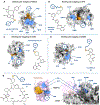μMap Photoproximity Labeling Enables Small Molecule Binding Site Mapping
- PMID: 37471577
- PMCID: PMC10809032
- DOI: 10.1021/jacs.3c03325
μMap Photoproximity Labeling Enables Small Molecule Binding Site Mapping
Abstract
The characterization of ligand binding modes is a crucial step in the drug discovery process and is especially important in campaigns arising from phenotypic screening, where the protein target and binding mode are unknown at the outset. Elucidation of target binding regions is typically achieved by X-ray crystallography or photoaffinity labeling (PAL) approaches; yet, these methods present significant challenges. X-ray crystallography is a mainstay technique that has revolutionized drug discovery, but in many cases structural characterization is challenging or impossible. PAL has also enabled binding site mapping with peptide- and amino-acid-level resolution; however, the stoichiometric activation mode can lead to poor signal and coverage of the resident binding pocket. Additionally, each PAL probe can have its own fragmentation pattern, complicating the analysis by mass spectrometry. Here, we establish a robust and general photocatalytic approach toward the mapping of protein binding sites, which we define as identification of residues proximal to the ligand binding pocket. By utilizing a catalytic mode of activation, we obtain sets of labeled amino acids in the proximity of the target protein binding site. We use this methodology to map, in vitro, the binding sites of six protein targets, including several kinases and molecular glue targets, and furthermore to investigate the binding site of the STAT3 inhibitor MM-206, a ligand with no known crystal structure. Finally, we demonstrate the successful mapping of drug binding sites in live cells. These results establish μMap as a powerful method for the generation of amino-acid- and peptide-level target engagement data.
Figures




References
Publication types
MeSH terms
Substances
Grants and funding
LinkOut - more resources
Full Text Sources
Miscellaneous

